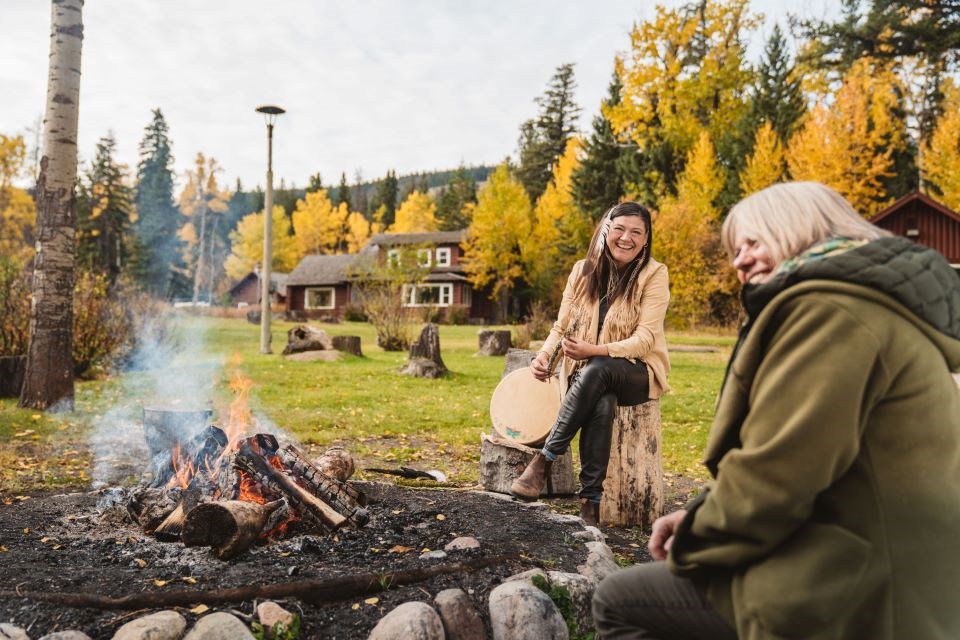In today's landscape, having an awareness of Indigenous culture allows a pathway to truth and reconciliation because it allows people to become curious about the First Peoples.
“Indigenous tourism, when it's done right, is led by Indigenous people. They're able to tell their stories from their own voices in real time and also dispel the historical myths that media has perpetrated over thousands of years,” said Matricia Bauer of Warrior Women.
“Indigenous culture is not just a picture of a totem pole or an Indigenous mural; it is the person and the story behind those processes and the practices. Indigenous tourism, when it's done right, allows those voices to speak up and be heard.”
Warrior Women is the cultural collective that she runs with her daughter, Mackenzie Brown. They offer arts workshops, drumming and other ceremonies and host medicine plant walks and other interpretive tours and performances.
Together, they operate primarily in Jasper but have traveled across Alberta and even internationally to share their stories, all while inviting the world back to the Rocky Mountains.
The group has been involved with Indigenous Tourism Alberta since its inception a few years ago. Bauer said that Warrior Women has benefited greatly from the partnership: with grant money and with advertising through its website and other forms of promotion.
“They've been incredibly instrumental.”
Warrior Women and the Jasper Tour Company are the only Original Original accredited Indigenous owned tourism experiences operating within the park, says Joe Urie.
Original Original is the Indigenous Tourism Association of Canada’s (ITAC) mark of excellence that assures that visitors are getting a quality tourism experience. Businesses that display the Original Original sign are accredited through ITAC, confirming that they offer products and services that are truly authentic.
Urie is the owner/operator of the Jasper Tour Company and vice chair of Indigenous Tourism Alberta. He sees a lot of growth ahead for tourists to have important and new travel experiences offered by Indigenous businesses. This is supported not just here in Alberta but also through the national organization ITAC.
He has been involved in developing a new experience in collaboration with the Métis Nation at Métis Crossing and through Parks Canada at Elk Island National Park. It débuted at Rendez-vous Canada held in Edmonton just last month.
“The Indigenous Tourism Association of Canada has an MOU [memorandum of understanding] with Parks Canada, which has seen the birth of a lot of new relationships with Indigenous experiences,” he said.
“Parks has expressed interest in promoting and partnering with Original Original accredited Indigenous businesses and with Indigenous communities whose traditional territories were taken, often egregiously, by the federal government and placed beneath the umbrella that is PC. I believe good things will come of this.”
Urie has nothing but praise for the collaboration that he has experienced with Elk Island National Park. He has high hopes for the same in Jasper National Park, although he sees it as a work in progress.
Tyler Riopel, chief executive officer of Tourism Jasper, sees the local gap. His organization strives to support the development of Indigenous tourism products and experiences “in any way, shape or form that it can.
He noted that the potential was huge.
“There's a massive interest. Globally, Canada is seen as a leader for Indigenous tourism product. We know that from a tourism side, especially in international markets, there’s a big, big interest and a big, big demand,” he said, agreeing with Bauer that it is essential – “critical,” in his words – for reconciliation.
“Indigenous tourism experiences, especially because of the culture, are rooted in storytelling and learning and education,” he continued.
This leads to the concept that Indigenous tourism also facilitates another new and growing concept within the tourism world: regenerative tourism. People want to come and leave a space better than how they found it. They want to visit places not just to see things but to understand them, Riopel explained.
That understanding, as Bauer and Urie said, cannot be done properly without the Indigenous perspective. Getting organizational supports through ITA or ITAC, Bauer continued, helps in so many ways to achieving that.
“It really does drive business towards you,” she said.




